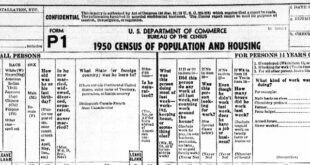In a number of recent columns, I have mentioned that one of the steps is to go out and find the death notice. It took a couple of e-mails asking “um ok. How DO you find the death notice?” to get me to thinking that I need to explain this process to you.
The death notice is a great tool for finding the names of the descendants of long-lost relatives. It’s not guaranteed and never comprehensive, but it’s always worth looking for.
From a death notice, you can (most of the time) find the following:
* Maiden names — Most of the time, but not always, the maiden name of the woman is listed. Sometimes, however, they say “beloved husband of Susan … ” and they don’t list her maiden name. If they later list “brother-in-law of Vito Battista,” it might mean that her maiden name was Battista. Another trick to finding the maiden name is to search for the death notice of her parents by searching for this couple. For example. You’re looking for the maiden name of Susan Giannelli, wife of Francesco. Search for “Susan Giannelli” and see if you find “Giuseppe Battista, husband of Rosa, beloved father of Susan (Francesco) Giannelli, … ” Now you know her maiden name is Battista.
* City in which the person died (rare)
* City in which the person was born (even rarer) — Only in smaller newspapers will you find the city the person died in or was born in. It might list where they lived, but that’s no guarantee they died at home. The Sun-Times and Tribune rarely list such details due to cost. The Daily Herald, Star, Economist and other local papers might have more detail.
* Names of the kids, and usually they’re in birth order — I have found that, most of the time, the kids are listed in birth order. If one or more of the children are already deceased, they are usually listed at the end, after the surviving ones.
* Names of the spouses of the kids — You can find out that people were married before to other people from an old death notice. Be careful with this knowledge. The person listed might not be thrilled when you ask them about their ex-husband Charlie Johnson. Obviously, at the time the parent died, their marriage to Charlie might have seemed like a good idea. Later on, she divorced him, changed her name back, burned all his pictures, and won’t mention his name ever again. And then here comes the curious genealogist. Be careful that you don’t burn your bridge. Anyway, that said, you can get the names of the spouses of the kids but rarely will they list the maiden names of the daughters-in-law. They’ll say “Joan (Henry) Sampson” and then “Frank (Nunzia) Scotello.” What’s Nunzia’s maiden name? See “Maiden names” above.
* Names of surviving, and sometimes, deceased siblings — Sometimes a death notice lists all the siblings, and sometimes they only list the surviving ones. In the age of large families, they weren’t thinking about the cost of placing a death notice. So when the middle child of a family of 13 dies at age 80, they lisedt all the brothers and sisters, and their spouses, and whether they are “the late.” But sometimes you find a surprise when they list “the late” guy, and you never heard of that guy. Often it’s a sibling who died very young and nobody talked about him, or a sibling who left the family and nobody spoke to or about him. Let me also say that, in families where some of the siblings came to America and some stayed in Italy, the death notice doesn’t always mention the ones in Italy. If a death notice happens to mention everyone, then it’s a good way to know a range of years in which all of them died. Uncle Frankie was listed as living in 1960 but listed as “the late” when Zia Maria died in 1977. So you have a limited range of years to search.
* Names of parents (rare unless the person who died was young) — When my great-great-grandaunt died in 1992, aged 89, her death notice actually listed that she was the daughter of the late Nicola Santoliquido and the late Maria Luigia Olivo. I think that’s the only time I ever saw the parents listed on an elderly person’s death notice. If the person who died was survived by a parent, naturally their name is listed. But the chance of someone’s parents being listed is pretty small, especially if the parents have been gone for a long time.
* Names of the grandkids (but they are rarely paired up with their parents) — Again, we’re dealing with numbers. If the person who died was the father of 12, and grandfather of 36, it is rare that they list all the names. Sometimes, even when there are a smaller number of grandkids, it doesn’t list names either. The problem is, when it does list names, it doesn’t always say which kid the grandchild belongs to. “Grandfather of Vito, Mary, Vitucc’, Anna, Maria, Vito, Roger, Skylar, Taylor, and George.” So you can’t really add them to the family tree because you can’t link them to their parents. You CAN store that death notice and later try to look up the person via Facebook or on-line.
* Funeral home
* Wake info
* Cemetery (this is getting rarer now) — Older death notices always list the name of the cemetery. Nowadays, there are a lot more cremations, and if the family chooses to either keep the ashes or scatter them, there will be no cemetery to visit. Also, there are a LOT more people choosing “Private Interment.” This means that the entire group of people won’t be gathering at the cemetery for a service or committal. This also means that even though the person is buried, you can’t find the name of the cemetery from the death notice.
* Photo — Once in a while, they put a little photo in the newspaper next to the notice. You should go on-line to find the better copy (color, for a start!) of that photo.
What do I mean when I say, “You should go online”? I’ll share you the pros and the cons next month.
If you have any questions, send me an e-mail at italianroots@comcast.net and please put “Fra Noi” in the subject line. Have fun!
Write to Dan at italianroots@comcast.net and please put “Fra Noi” in the subject line.
 Fra Noi Embrace Your Inner Italian
Fra Noi Embrace Your Inner Italian





